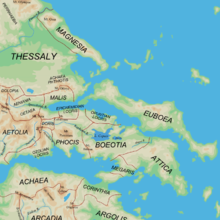Oitaier
The Oitaier or Oitäer ( Greek Οἰταίοι / Oitaioi ) were a Hellenic people in ancient Greece , which the eponymous region Oitaia in the south of Thessaly lived.
geography
The settlement area extended in the south of the Spercheios valley from Tymphrestos to the Malian bosom . The mountain ranges of the Parnassos and the Oite demarcated Oitaia from the landscapes on the Gulf of Corinth .
History and politics
The Oitaier originally came from Ainianen , Malians and Dryopern from which had come together in the region. Their residences were at the beginning of the 5th century BC. In the upper Asopos valley. From here they invaded the areas of the Trachinians and Dorians . The fortress of Herakleia is said to have been founded by the Spartans at the urging of the Dorians as a bulwark against the mountain peoples. 371 BC Then, after the walls had been razed, Jason of Pherai gave the city to the Oitai people. Other important cities of Oitaia were Trachis , Dryopis and Antikyra .
The Oitaier were founding members of the Amphictyon League and later joined the Corinthian League and 280 BC. In the Aitolian covenant . In the Lami War they fought on the side of Athens . At the time of its greatest expansion, Oitaia was divided into 14 demes . 167 BC The country came free from the Aitolians and formed its own Koinon . Under Augustus , Oitaia was united with Phthiotis and then gradually lost its importance.
mythology
Heracles is said to have burned himself at the stake on Mount Oita ; the grave of his wife Deianeira was shown at Trachis.
Ariston, a general of the Oitaier, lost his wife to the tyrant Phayllos because of the Harmonia's collar .
The Oitaians revered Heracles as a deliverer from a plague of locusts .
literature
- Friedrich Stählin : The Hellenic Thessaly . Stuttgart 1924, pp. 191ff
- Ernst Kirsten : Oitaioi. In: Paulys Realencyclopadie der classischen Antiquity Science (RE). Volume XVII, 2, Stuttgart 1937, Sp. 2289-2294.
Individual evidence
- ↑ Thucydides : The Peloponnesian War 3, 92, 2f.
- ↑ Xenophon : Hellenika 6, 4, 27.
- ↑ Strabo : Geographika 13, 1, 64 (web links in ancient Greek , English )
